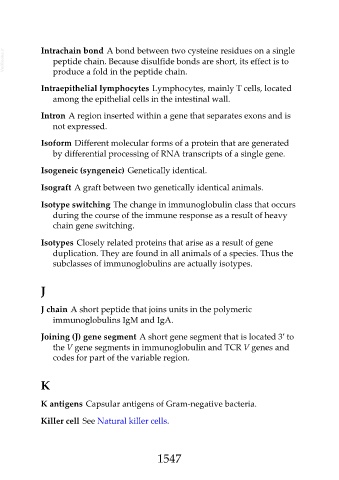Page 1547 - Veterinary Immunology, 10th Edition
P. 1547
VetBooks.ir Intrachain bond A bond between two cysteine residues on a single
peptide chain. Because disulfide bonds are short, its effect is to
produce a fold in the peptide chain.
Intraepithelial lymphocytes Lymphocytes, mainly T cells, located
among the epithelial cells in the intestinal wall.
Intron A region inserted within a gene that separates exons and is
not expressed.
Isoform Different molecular forms of a protein that are generated
by differential processing of RNA transcripts of a single gene.
Isogeneic (syngeneic) Genetically identical.
Isograft A graft between two genetically identical animals.
Isotype switching The change in immunoglobulin class that occurs
during the course of the immune response as a result of heavy
chain gene switching.
Isotypes Closely related proteins that arise as a result of gene
duplication. They are found in all animals of a species. Thus the
subclasses of immunoglobulins are actually isotypes.
J
J chain A short peptide that joins units in the polymeric
immunoglobulins IgM and IgA.
Joining (J) gene segment A short gene segment that is located 3′ to
the V gene segments in immunoglobulin and TCR V genes and
codes for part of the variable region.
K
K antigens Capsular antigens of Gram-negative bacteria.
Killer cell See Natural killer cells.
1547

